Part 3: Phase II: Expansion Part I(2323 - 2337)
Thanks all! Onwards then ...Phase II: Expansion Part I(2323-2337)
Yeah, so basically I'm a liar. No way I'm covering the whole 27 years in this update, what with two more in-depth screen/feature descriptions and lots of other stuff going on. I still think I'll eventually get to doing 25-year updates, but maybe not; there's a point at which I don't think it's helpful to have novellas rivaling the Encyclopedia Brittanica for length.
Originally I intended to start off this update by talking doing a more in-depth racial distinctives of the Psilons, and then move into talking about Tech research in Master of Orion. Then I remembered those are the same thing. Psilons straddle the baseline in all other matters. Diplomacy is neutral, as are spying, economics, and warfare. Technology is their lone distinctive.
At the end of our last discussion I mentioned that it was time to shift Mentar from building up industry, and tech is what to shift it TO in this situation. We'd prefer to just send out more colony ships, but we need more range first. So off we go to the Tech screen.
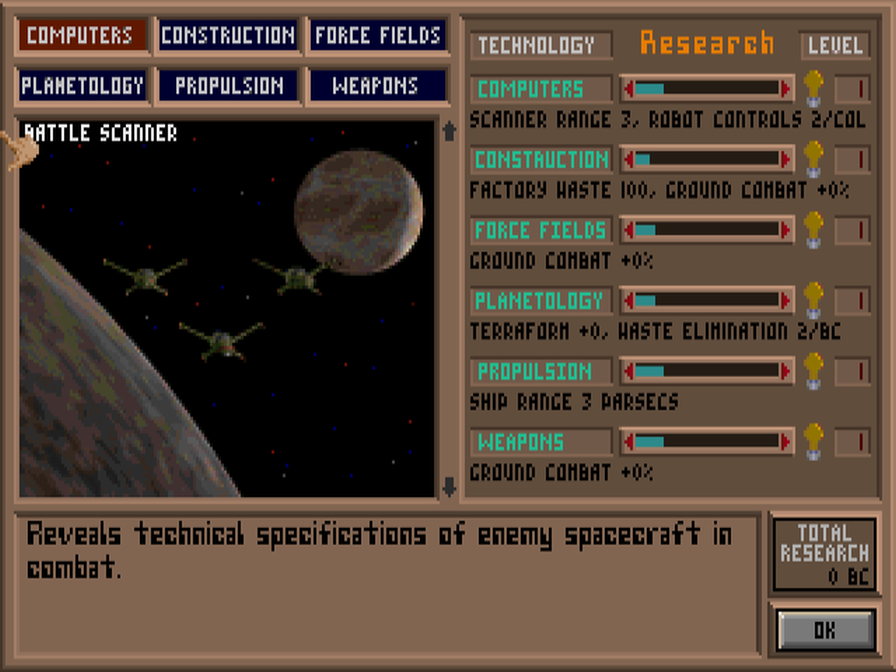
This will take a bit of a text wall. Technology is the most complicated system in Master of Orion, and also ultimately this most important. To start with, there are six fields as seen in the upper left; selecting one lists all the advances researched in each one, along with the current project. There are no current projects at game start however. On the right we can see our current level in each field, a couple basic facts about fundamental abilities related to them, and set our spending for each. This works just like planetary sliders; they can be locked, increased or decreased. The pool of RP(research points) at the lower right is at nothing right now but that will soon change. That's our currency here.
Back to those six fields of study: here's how the manual describes them.
Computers "deals with the development of specialized electronic devices and computer systems. Computer tech produces such devices as battle computers, ECM jammers, robotic controls, space scanners ... " Mostly this is stuff you put on ships, but sensor range from planets and some economic techs as well.
Construction "is a generalized form of engineering primarily dealing with advanced structures and materials. Construction tech can be used to develop advanced armors, reduce industrial waste emissions, and decrease the cost of building new factories." Basically stuff gets built cheaper and more efficiently, including ship components, along with more effective materials.
Force Fields "involve the practical application of advanced fields physics such as deflector shields, replusor beams, stasis fields, damage shields ... " Pretty self-explanatory.
Planetology "involves the analysis and development of alien worlds. Planetology can be used to develop technology that will eliminate waste more efficiently, expand the livable terrain of planets, and allow colonists to land on planets with hostile environments." Getting the most out of the physical matter of the star systems in our galaxy.
Propulsion "develop new and more powerful ship engines, extend ship ranges, and construct special power systems" Those power systems take various forms, but almost everything in this field is put on a ship, and even those that aren't are related to fleet movement. Navigating the galactic space-time continuum, you might say.
Weapons "deals exclusively with the development of advanced weapon systems." This includes the armaments of our ground troops, but will focus mostly on weapons for use in space.
Every race in the galaxy has certain affinities for these fields and certain weaknesses: every race except one. That's us, the Psilons. In each technological field there are four possible ratings:
** Excellent -- One race is the best at each category, and they require only 60% of the normal investment to research new advances in that field.
** Good -- Better than average with 80% investment required.
** Neutral -- The standard amount.
** Poor -- 125% of the normal investment is required.
Additionally, the better rating a race has in a particular field, the more choices they will have to choose from. A weak field limits the options, requiring a race to either go without or find other ways to acquire the knowledge.
Psilons are rated Good in all categories. This is part of their research advantage. They also are much more efficient, with a 50% bonus to all research efforts. Usually 1 BC invested in tech equals 1 RP: for us it equals 1.5. Combined, these give the Psilon a huge, huge 75% edge against an 'average' race.
There are several more rules or concepts that are important when it comes to technology in Master of Orion:
** Steady, long-term investment is favored over a 'crash' program. The mechanism for this is 'interest' awarded for research on a particular project. The amount is the lowest of two options: the amount invested this year or 15% of the total to date. Furthermore, you lose 10% of your investment in that project annually if funding is cut off completely.
** The current tech level, or TL, is calculated as 80% of the highest-level advance plus the total number of devices in that field. This makes the higher-level advances the most valuable while ensuring that all new studies, no matter how mundane, will have at least some minimal value. TL is not merely a score or an abstratction, because ...
** As the TL increases, previously discovered advances are made cheaper and miniatuarized. Generally the cost is reduced by 5% per TL, and size by 2.5%. Therefore you can cram a lot more on a ship as time goes on, for example, as basic components can be used far more efficiently.
** There is some variety baked into the completion date, eliminating total predictability. Once the 'cost' of a project has been satisfied, there will be a % chance of finishing each year, increasing as long as funding continues until discovery is made.
** Not nearly as well known, and not documented in the manual(though implied by the tech chart) is the fact that the 50 TLs of advancements are divided in 10 'tiers'. To have access to a tier's advances, you must research one in a previous tier. For example, in the first tier of Weapons there are the following advances:
L1 -- Lasers and Nukes. The basic weapons you start the game with already researched.
L2 -- Hand Lasers.
L4 -- Hyper-V Rockets.
L5 -- Gatling Laser.
When starting up Weapons research, we will have at least one of these available as a choice(one advance from each tier is guaranteed at a minimum) and possible as many as all three of them. Our Tier II choices will be unlocked as possibilities after finishing whatever we choose here. This provides an incentive for pushing up the tech tree for new, groundbreaking technologies ... but in doing so, you may find yourself bypassing items that won't unlock a new tier, but could more quickly provide a benefit now. It's another short-term vs. long-term concept.
This is one of those areas that turns me into a real fanboi, I admit without shame. There may be games that do something that I haven't seen, but I flat-out think this is the best overall research system I've ever seen in any game. Others have done parts of it but nobody carries it off as well on the whole. Really the only two criticisms I can even level here are that I think the cost/size reductions are overdone and should probably only be half of what they are as well as being limited, and that I'd like to see more variable race-specific tech(i.e., armors, weapons, planetary developments, etc. with some variability from game to game and not always the same each time). That's it though. The way it all fits together and plays out is one of those things I gain more and more appreciation for the more I play. It's really elegantly and brilliantly done IMO. Clearly it really mattered to the design team to get this right.
Now that all that blather is over with, what are we to do with this right now? We need to increase our ship range to colonize Imra; that means propulsion tech. We can't research just yet though; our scientists need to take the next year to come up with our initial research possiblities, which they will do if we invest a modest amount. Given that we have equal ability across the board, we'll do best here to hit the = key and equalize spending across all fields. We're only going to focus on propulsion, but we can't actually dump a bunch of effort into that until we have something to dump it into. Might as well see our choices in the other fields while we are at it.
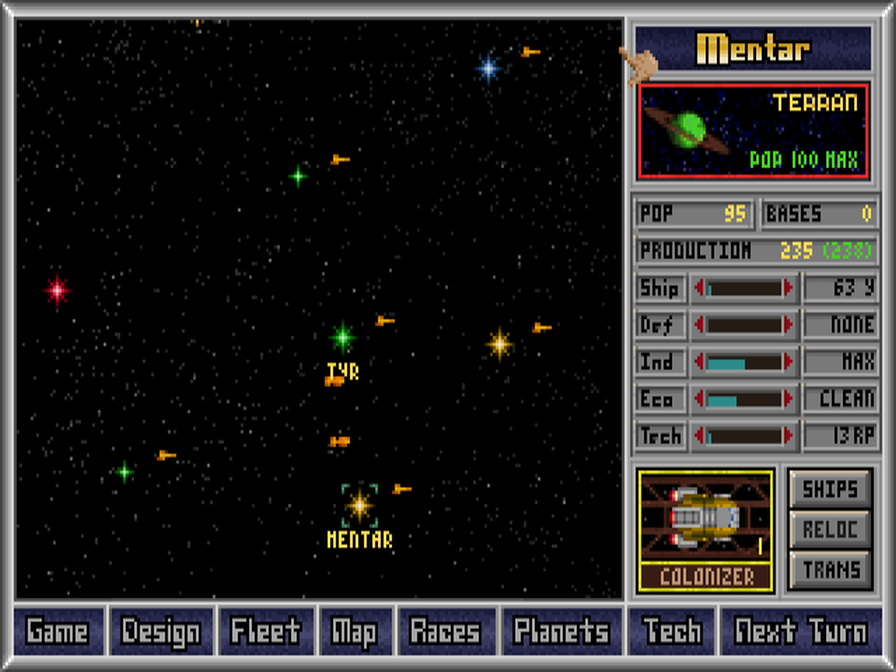
This only requires a minimal investment, a couple of points in each field. 13 RP will give us at least 2 in each, and that's plenty. However, that still leaves us with more than enough left over to max out factories on Mentar, so we'll actually put just a bit into shipbuilding here on a new Colonizer. We're not going to actually build it yet, but getting the work started is the best use of that small fraction of remaining production. Grab every tiny edge you can get.
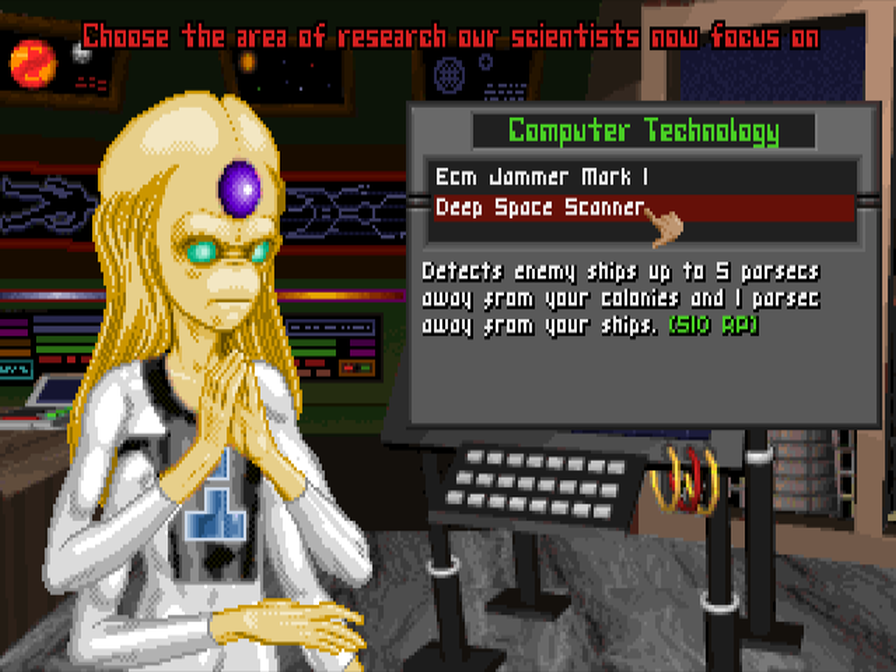
Accompanied by it's own little musical jingle, this screen comes up whenever you have a new research option. Usually that means you've completed a previous one, but here we are first starting out. Computers is up first, and we get a bigger, better Psilon portrait of a researcher here. We have to choose between 120 RP for ECM Jammer Mk. I, which will make it harder for enemy missiles to hit our ships if they are equipped, or a Deep Space Scanner. I had a picture for each, but I was a dufus and forgot to save the first one. These are more expensive and extend our scanning range to something slightly less inadequate than it currently is.
Few of these choices are gimmes. I really like the scanner tech as knowledge is power; having a little more warning of other empires' fleets moving about would be quite useful. The ECM Jammer would give us a quick cheapie and unlock Tier II faster. Even so I normally go with the scanner, but given how we are effectively cut off and isolated right now in our corner of the galaxy, albeit temporarily, I side with the ECM, the idea being we don't need the scanner just yet.

A Psilon researcher is rarely without options, but that's the case here. Reduced Industrial Waste 80% does pretty much exactly what it says. It'll take a bit of work to acquire but reducing our waste cleanup budget is a very worthy goal.

Once again no choice to be made, but that's because there's only one Force-Field tech in this tier so it'll always be the only option. Class II Deflectors are a mid-level cost tech and will give us improved defensive capabilities.
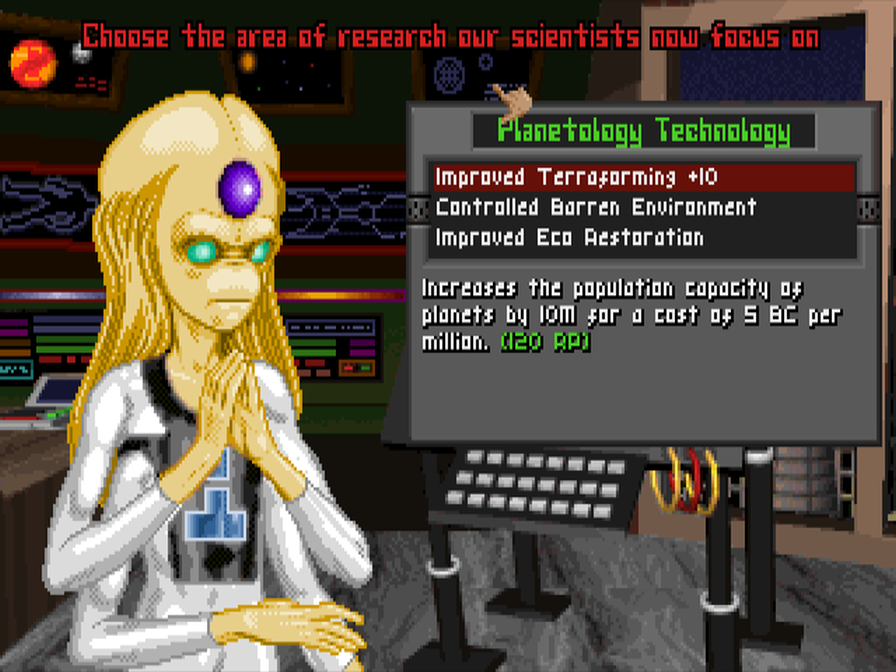
A wealth of riches here, and Planetology is a crucial field early. Terraforming +10M is very cheap and allows us to increase the potential of all planets right away, though we do have to make the investment on each planet once the knowledge is acquired. Since it's a flat-rate increase, smaller planets will benefit the most from this.
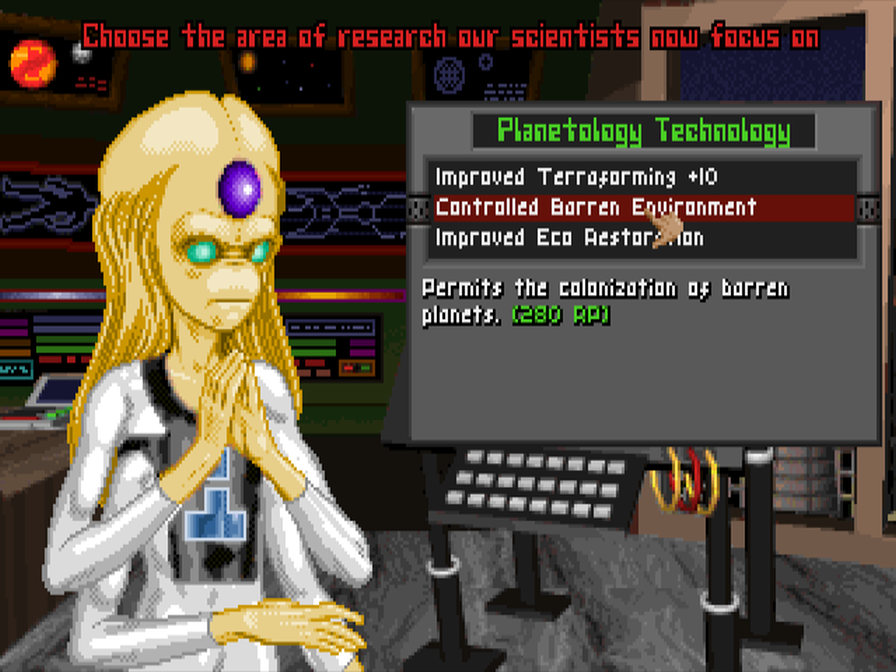
We can get started on hostile planet colonization early if we wish. There is that barren system in the middle of the galaxy ... but we aren't close to having enough range to reach it. It's doubtful we'll have a use for this anytime soon, and colonization techs are inclusive. By that I mean that researching, say, inferno colonization also allows you to land on any planet less hostile(barren, dead, etc). For that reason it's often best to skip barren and grab one higher up the ladder so to speak, unless you have nearby barren worlds, which we don't. We'll pass here.
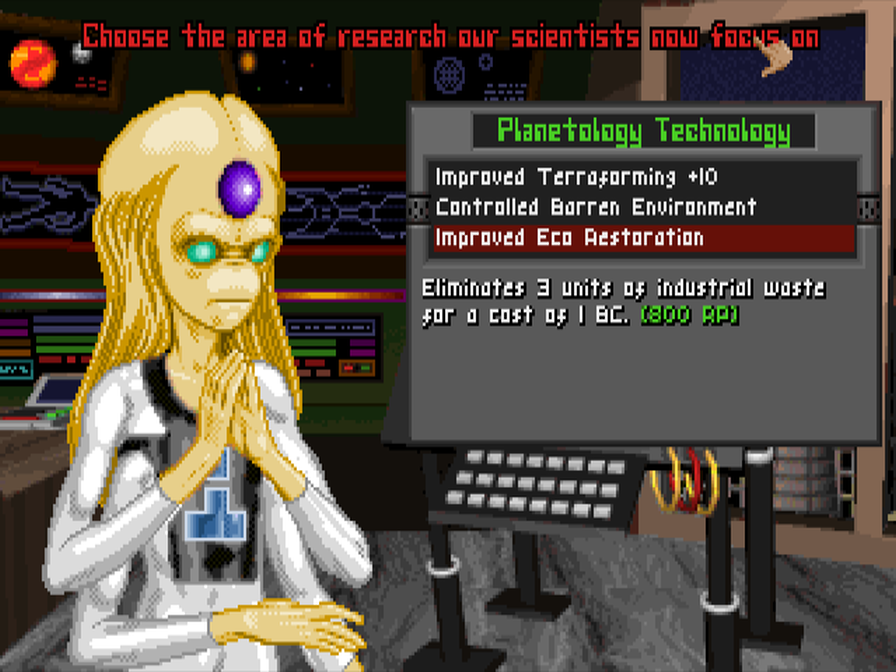
A little pricey, but this is a HUGE early tech. Cleaning up 3 waste/BC is a 50% improvement on our current 2/BC. Put differently, it would allow a one-third cut in our ecology spending immediately.
It's a tough call here between terraforming and eco restoration. You could argue it either way, and I almost picked eco restoration here. The thing is, terraforming is so cheap, and the option of taking that, then having planets terraform while we push up to eco restoration or something else ... just knocking that out of the way quickly seems to be the way to go.
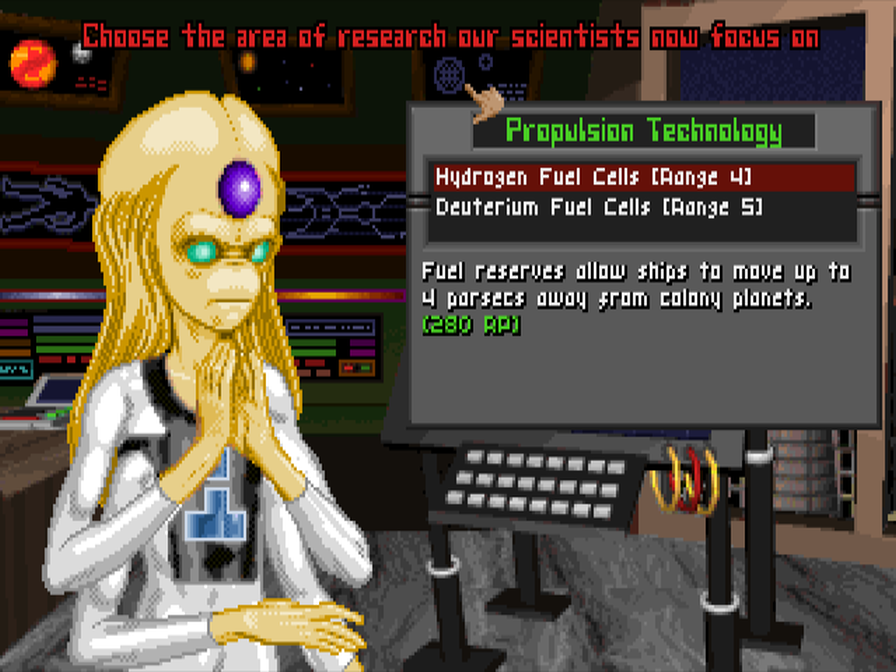
Propulsion. This is what we came here to see. The right choice here is very situational, and Imra is four parsecs away so there's no reason to overspend; we're going with the cheaper Hydrogen Fuel Cells.
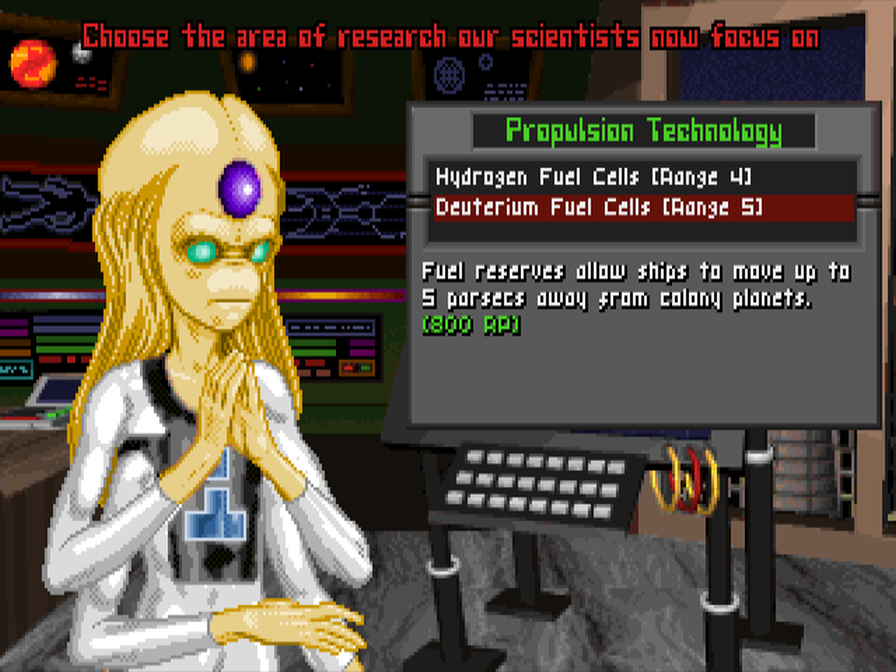
Deuterium fuel cells will either wait, or be skipped entirely in place of something better.
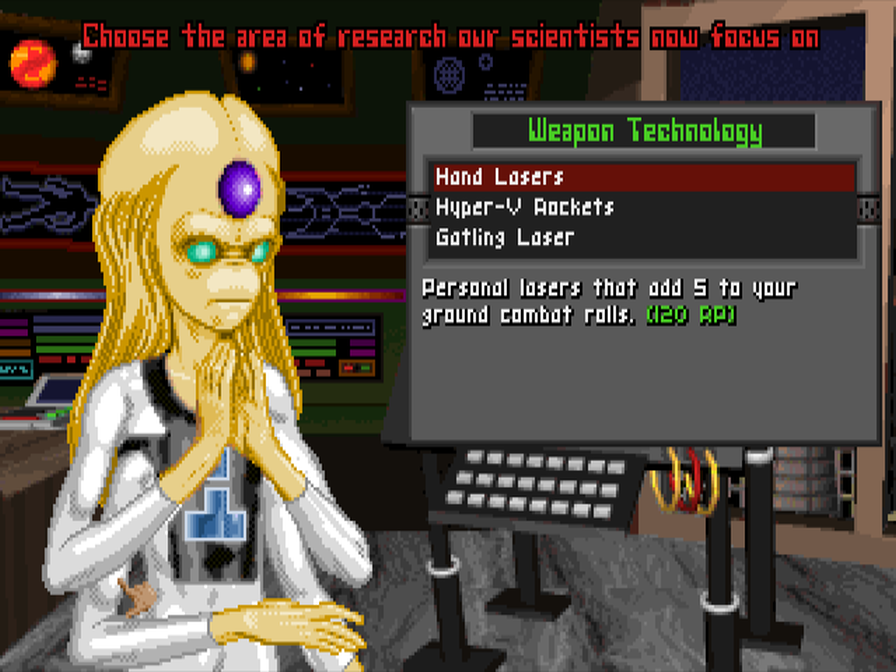
Weapons is our last field to decide, and there are three more choices. Hand Lasers are the cheap option. We'll get more into how ground combat works later on whenever it comes up. These can be important in border disputes, but it doesn't appear we are going to have them anytime soon. There are times when it's important to get these, but we'll bypass them this time.
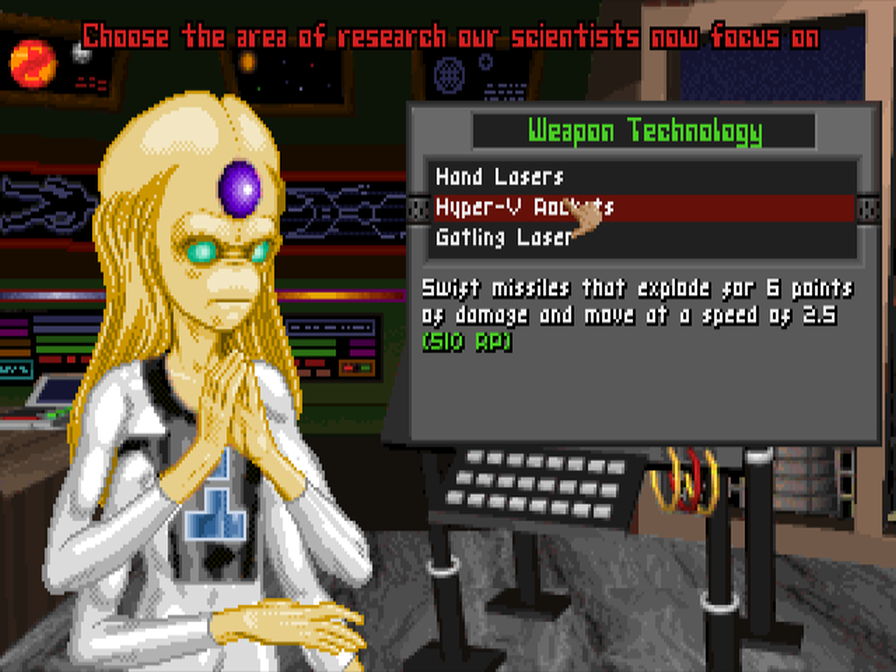
Hyper-V Rockets are a significant improvement over our starting nuclear missiles, and are worth serious consideration.
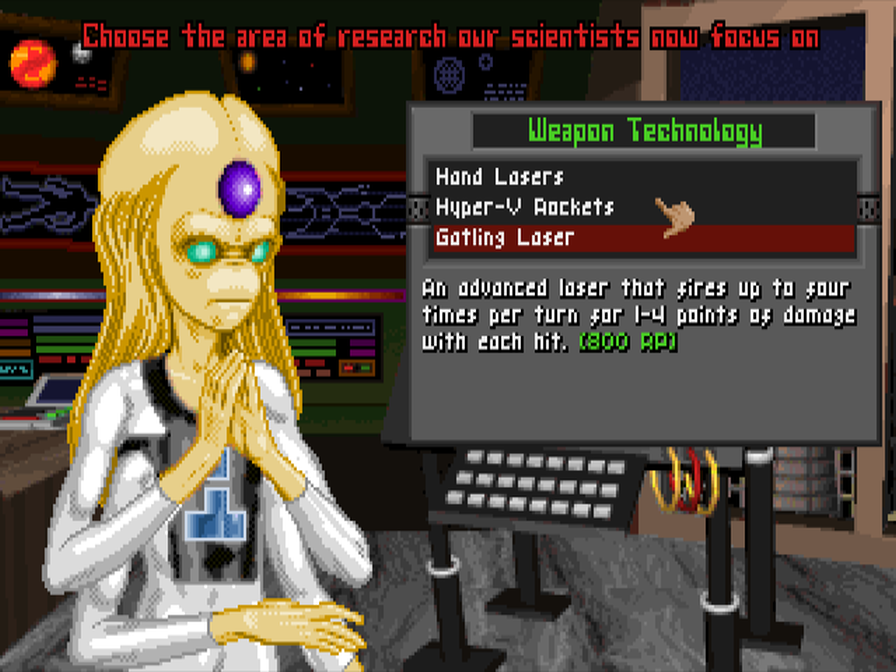
The rapid-firing Gatling Laser is a game-changer for a brief period of time until it becomes obsolete. That narrow window of opportunity means it is fairly often a poor investment.
Given our position in the galaxy, the Hyper-V Rockets are definitely going to be the most useful. And that's wraps up our initial research choices.
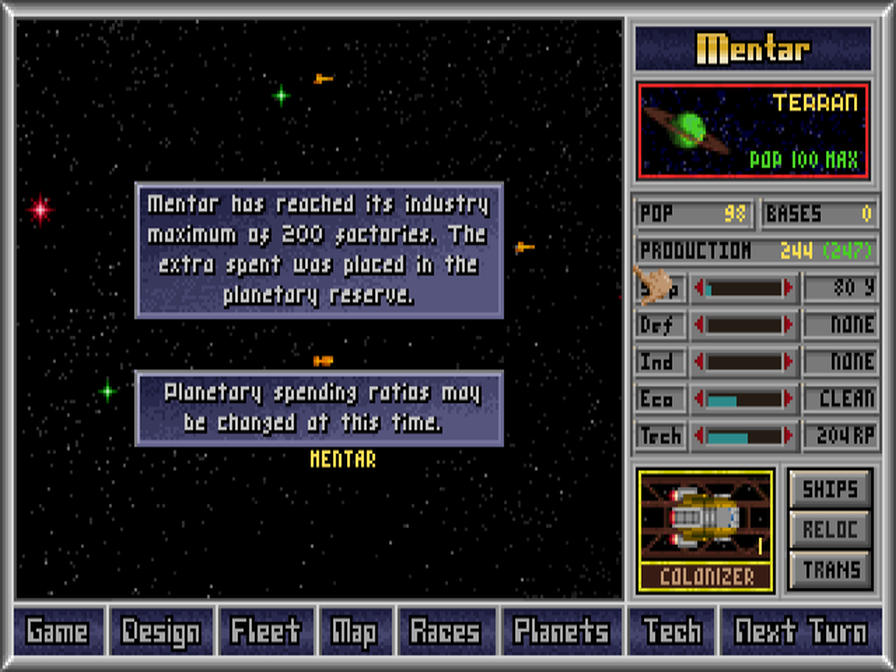
This notification happens whenever a planet reaches its limit on factories or population. But what's all this about the planetary reserve? Let's take a look, back on the Planets display.
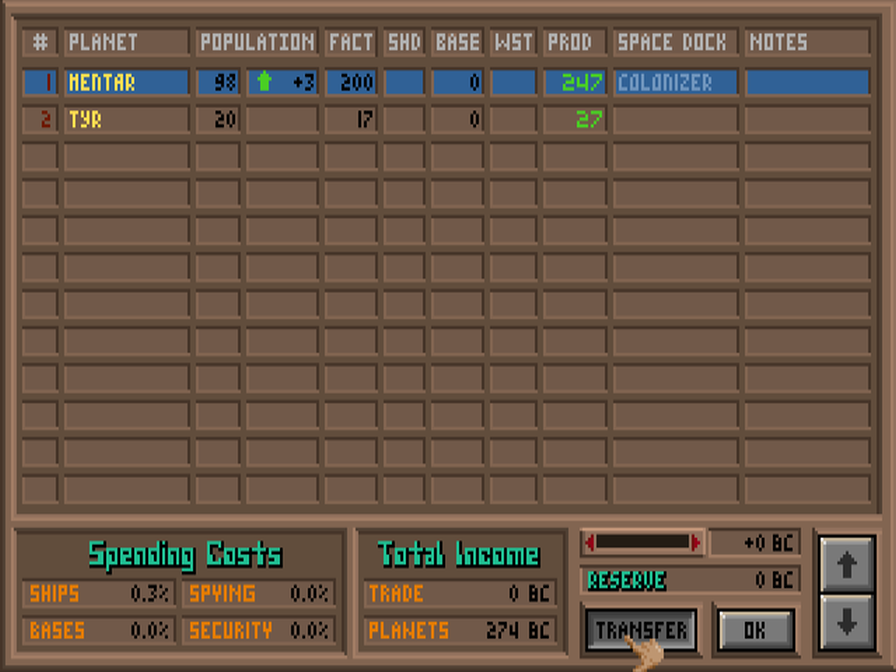
On the lower right, it looks like I've just clicked on the TRANSFER button but I actually haven't; it's depressed like that already because it's inactive. That's because, as you can see directly above, there's no money in the reserve. I was right on the button and didn't have any extra invested in industry to go here. That pop-up message about the 'extra spent going into the reserve' appears whether there was actually any extra or not. Usually there is.
Anyway, the planetary reserve is another one of those features that I think is a superior alternative to the idea of 'buying' or 'rush job' production. In most strategy games, a sufficient amount of treasure will allow you to finish building something immediately. In Master of Orion, the most you can do is double the rate of production; one can think of this as threatening the workers or mandatory triple overtime or whatever, or perhaps imagine Vader's visit to the second Death Star("I hope so for your sake, commander. The Emperor is not as ... forgiving ... as I am.")
There are multiple ways to get money into the reserve. Overruns like this one are one way; investing in industry when a planet is maxed out on factories will do it as well(but at a 50% discount, only half the credits will actually go into the reserve); when you scrap a ship design, a quarter of their build cost goes into the reserve as well; and on the screen you can clearly see a slider which can be used(at the same 50% discount) to essentially 'tax' all of your planets by a certain amount. When there's something in the reserve, it can be transferred to any planet. I'll show that mechanic when it comes time to take advantage of it.
I think the MOO Planetary Reserve is an excellent feature; it's simple and balances the ability to bootstrap production where needed with a realistic limit on that ability.
Now that we have our tech choices, Mentar throws all of it's disposable production into research, while Tyr will continue building up.
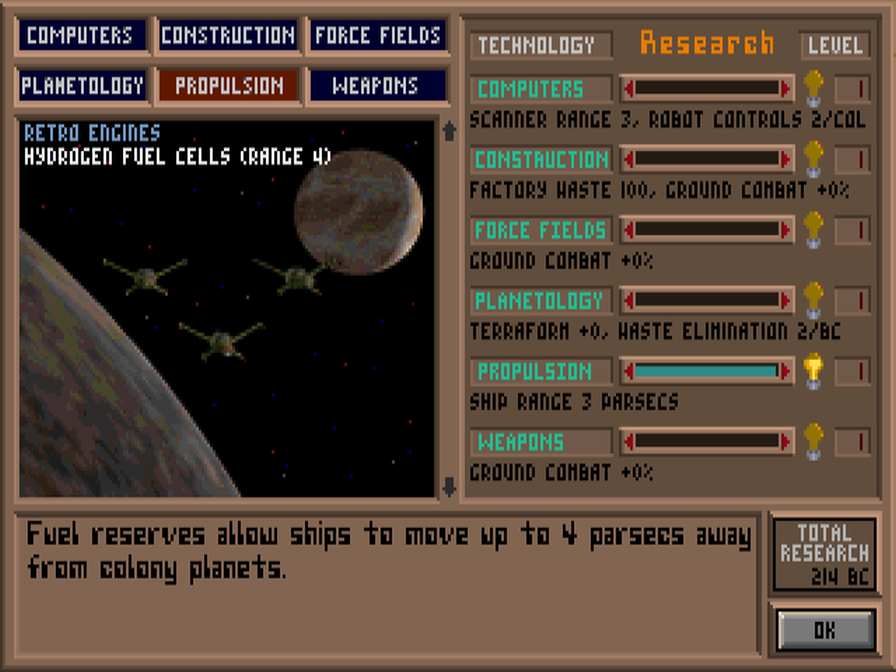
Back on the technology screen to show a couple things. We've got 214 RP going, and every last drop of it into getting the fuel cells to increase our range and get to Imra. Notice the light-bulb on the right of the full propulsion slider: it's most of the way full. When that fills up all the way, we'll begin to have a chance at this breakthrough. While it is best most of the time as I mentioned to invest a little at a time, right now we just need that range extended and we need it absolutely ASAP. When you've got to have something and don't care about the inefficiency of investment, a crash program still works. You just don't want to make a habit of it.
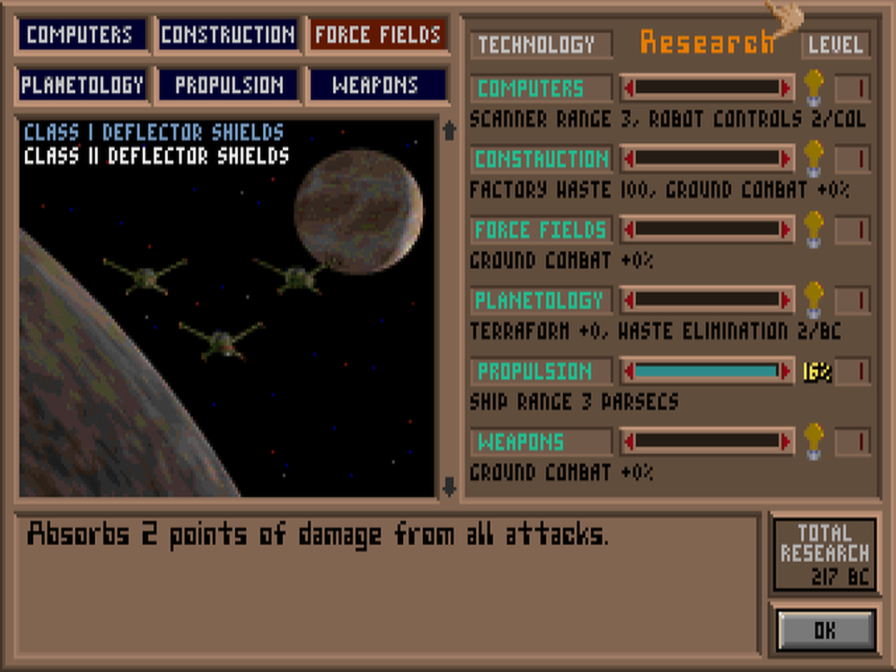
This is a year later with nothing changed. The light-bulb is replaced by '16%'. There's a bug that causes this to display only half of the actual chance of discovery: we have a 32% chance of getting Hyrogen Fuel Cells if we maintain this level of investment. However that's actually not what we want to do -- because we'd then have to wait for the colony ship to be built. Instead we'll start that right now, and shift Tyr over to research. It'll take 4 years for Mentar to build the ship, and by then we'll be closer. The idea of all this is to have the ship ready and the research finished at the same time, for the purpose of getting under way to Imra as soon as possible. Tyr's industrial buildup will be paused in order to achieve this, but that's an acceptable sacrifice.
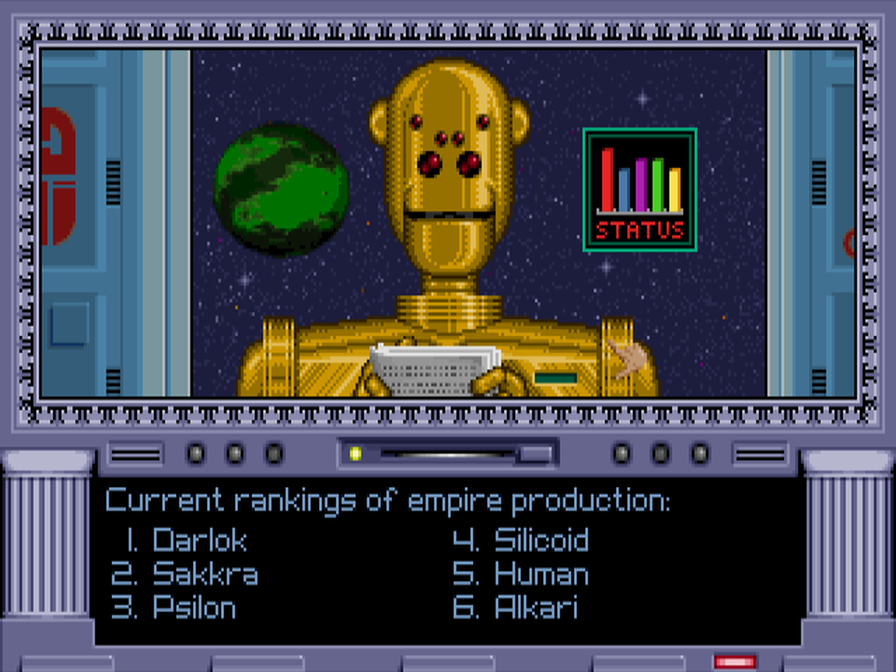
Another year, and it's 2325. GNN is back with production rankings. This gives us a sense of who is doing well. For the Psilons to have a poor second planet and be #3 here is surprisingly good. This tells me that the three races below us(Silicoid, Human, and Alkari) are probably stuck in situations where they haven't been able to expand yet. We'll hear periodically from the Galactic News Network on a few different subjects, at seemingly random intervals. I've seen them give the exact same report twice in three years with no new information. The robotic news director is perhaps not the most forward-thinking individual.
Meanwhile, with three years left to go on the colony ship, we're up to a 10% chance of finishing our research.

It's 2328 now, and you can see Mentar pulling a little back into research from shipbuilding. The reason for that is we'll still finish the Colonizer this year. Master of Orion does have 'overflow', meaning that if I invest more it'll carry over to the next ship and give partial production. I don't want to do that though, because we still haven't finished the fuel cells project yet. As it happens, with this spending and Tyr's continued minor efforts, we're at an even 50-50 shot at getting it this year. If it was much below that I'd probably pull even more out and wait another year before finishing the ship.
2329 comes and the ship is finished but we still don't have the range we need. The odds are not in the Psilon's favor. Pretty low chances of getting this far and not achieving the breakthrough, but the muse of invention can be fickle(and RNGs as well). At this point Mentar can put enough into job to guarantee completion, so Tyr goes back to building factories.
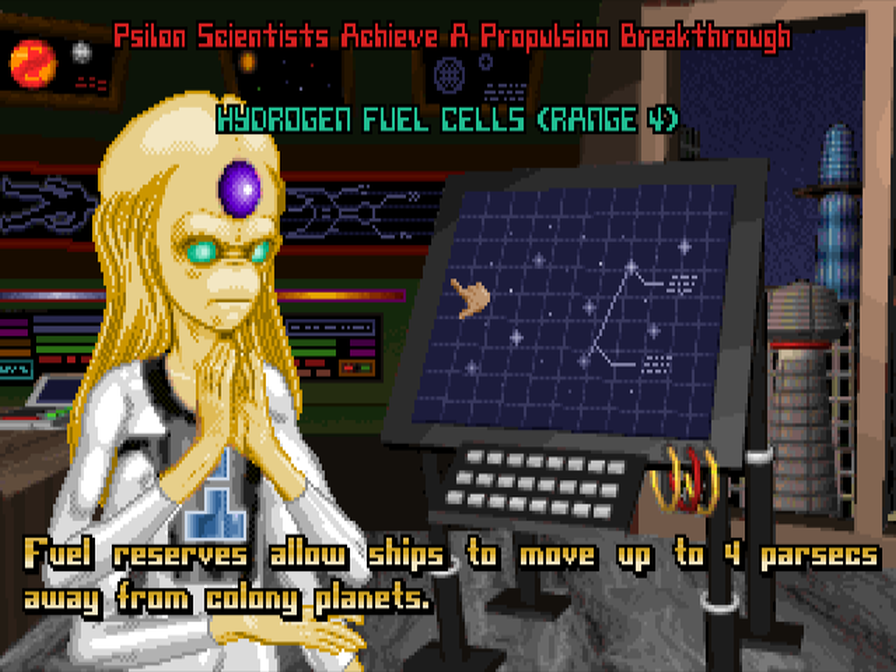
Here we are. Three decades into our journey and the Psilons have made their first research advancement. With some advances there will be an action to take with a prompt for that, but usually it's just a matter of being notified and then choosing the next project ...
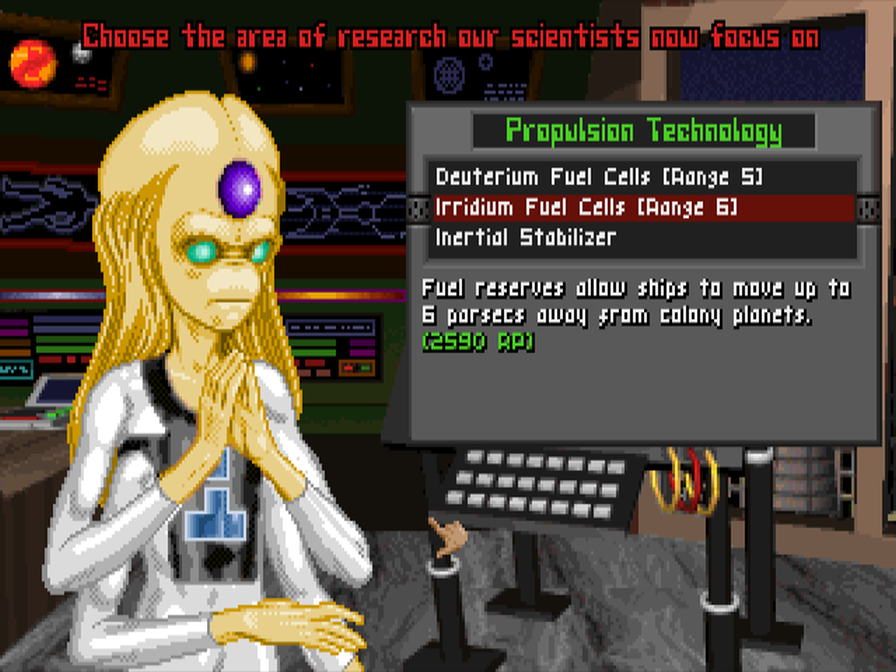
We've got two new choices. You may recall than Deuterium Fuel Cells were at 800 RP. Now we have access to Tier II Propulsion possiblities, and the cost goes up considerably. These are always ordered by tech level, and the price goes up with that so it's lowest to highest every time.
The only real reason we'd have to go for Deuterium cells here would be if there was something we really wanted to get to 5 parsecs away. Otherwhise it's either the Irridium Fuel Cells here or the last choice to advance another tier. It's worth noting here that Irridium cells would likely put us in contact with the Darlok and Alkari, who we know possess planets exactly that far away ...
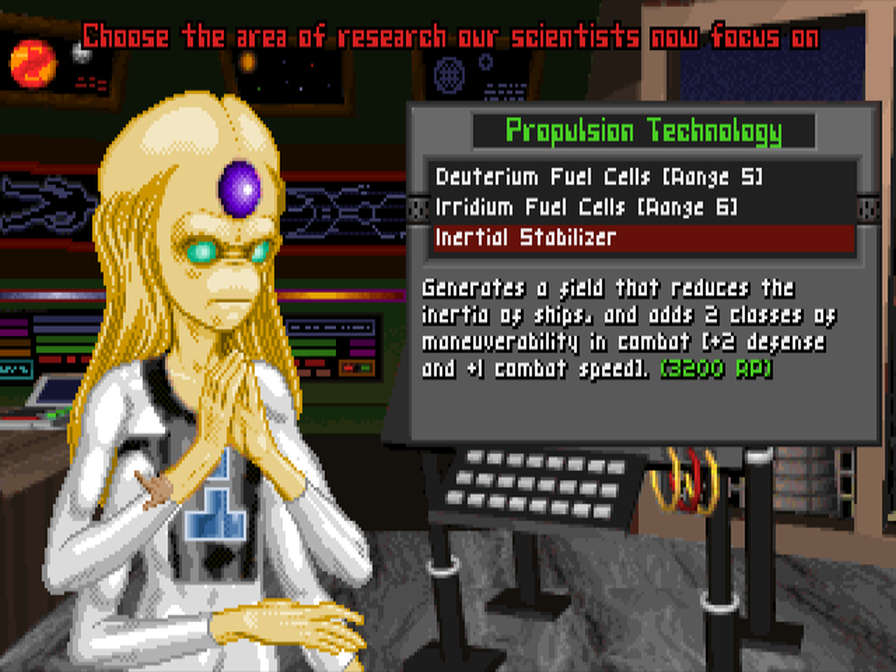
The Inertial Stabilizer is quite useful in combat, adding considerably to our ability to avoid fire. The choice here basically boils down to how happy we are with what will soon be our four planets in this corner of the galaxy. Is it more important for us to stretch our legs so to speak, or should we focus on being able to defend ourselves?
In a larger galaxy, range would almost certainly be more important. Here, the chances of being able to reach a planet nobody else has seized yet seem at this point unlikely ... but we can't be sure.
I'm not at all sure I'm doing the right thing, but I choose Irridium Fuel Cells and go for the range. Even if I can't do a darned thing about it, I like knowing what's out there. The choice to try and join the galactic community earlier rather than later is a very double-edged one, and we may well find out that the Psilons would have been better served to go for the maneuverability advantage. Time will tell.
It's easy to forget that the range of our scouts has also increased to seven now(four plus reserve fuel tanks). That brings only one more system within our reach, which I think is not habitable anyway: it's near the Alkari and they'd have colonized by now and be buzzing around us more I think. Regardless, we'd like another Recon ship to go head out there. Our Colonizer heads off to Imra, Mentar focuses on building another one, and Tyr will divert enough resources to get that scout going. We'll want to start up again in a more broad-based effort soon, but all research efforts are suspended for now.
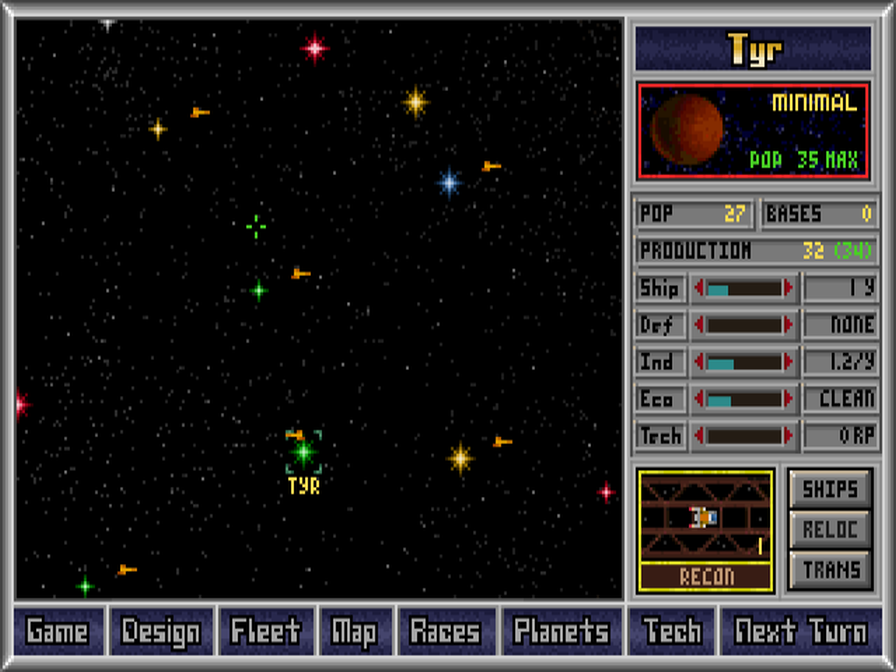
Most of the time I won't show these kind of mundane logistical details, but they are important. There's another Relay situation going on here. Tyr is building a Recon, so I send the one in orbit on right away to Arietis, the green star above. When it's a year away, the ship there will depart and head out, you can see the red-star destination at the top of the screen. It probably won't matter in this case, but this will drop two years off the journey compared to waiting for the ship to finish at Tyr and then sending it directly.
These plans are executed and by 2334 we have added Imra to our empire, though with only a minimal 2M population.
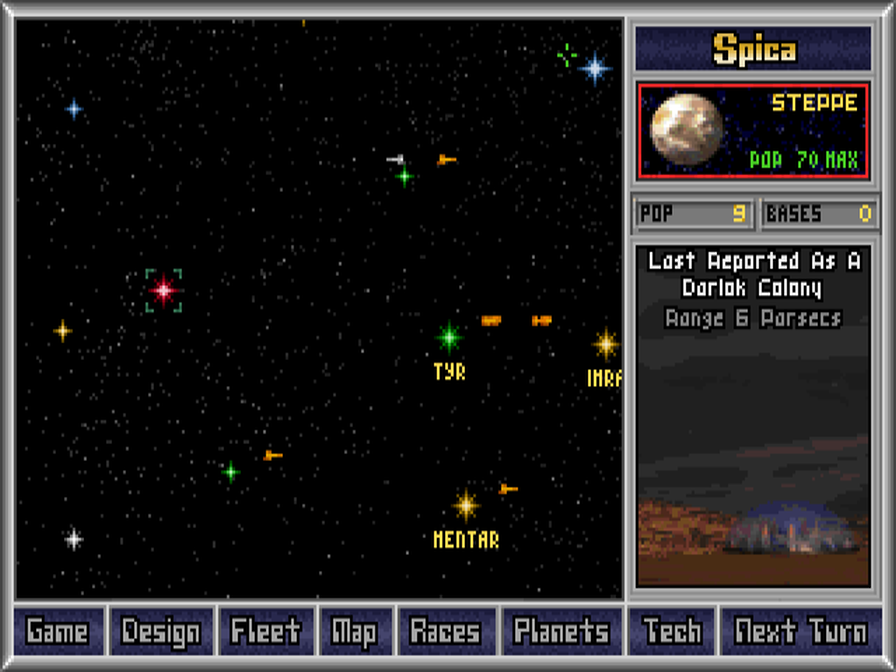
Before moving on I just want to highlight this. The Darlok colony Spica, many turns after we left. It shows the last data we know of(Last Reported As ... ) since we don't have scanners that can give us any information that far away and no ships in orbit anymore. I love it when games get these kinds of details right. It's a small thing, but it's exactly as it should be.
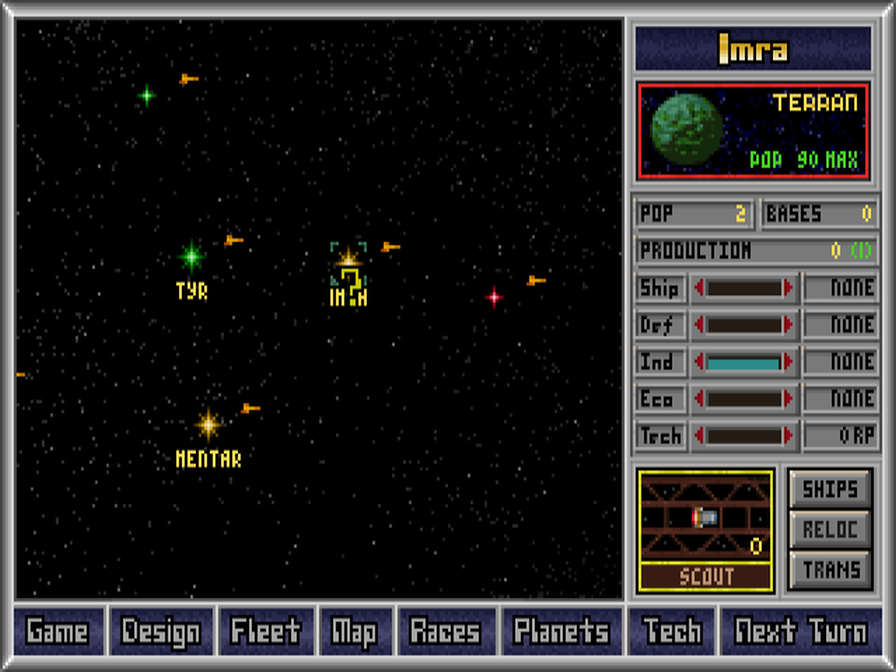
It's time now for us to transition into a new phase of the game. It's been an unusual start in that we haven't had a lot of tough choices and have a band of hostile/uninhabitable systems separating us from the rest of the galaxy. Here's what's going on:
** We'll want to send more colonists to Imra to get it up and going faster. Eventually it will be nearly as productive as our homeworld of Mentar.
** Our initial expansion phase is almost complete, as a minimal investment will get another Colonizer finished next year, and then it will head out to Denubius, the desert system to the right of Imra. This will not expand our range at all as it's on the edge of the galaxy.
** The Recon ship headed upwards from Tyr is two years away from its destination.
It's pretty rare, and almost unheard-of on some of the bigger galaxy sizes, to have this kind of clearly defined transition point. Usually it's more of a gradual process of realizing it's time to invest in other areas besides grabbing up star systems, and things like research and military buildup at least for self-defense if not for border disputes or even outright war come into play. Being isolated makes things simpler, but we still must make priorities. This is the point in the game that I start to feel less confident in and am sometimes unsure of what to do -- or even royally screw up. Before this LP is over, you'll see that multiple times I'm sure.
There's no way to know how soon it might change, but we really don't have a need for a navy yet or building defenses. Nobody's even sniffing around the barren planet we have picketed, much less the radiated or toxic ones. This is very, very rare; I'd expect more activity by now, and that reinforced my impression that others may be off to a rough start. Under those circumstances it seems best to me to focus on getting Imra and Denubius up and running as quickly as possible, accelerating this end of that growth curve, and snag some tech especially some of the economically beneficial early ones.
First up, I transfer some population to Imra; 13M from Tyr and 15M from Mentar. That's a lot of people to have just hanging out in space for the four-year journey and not producing anything, but it'll be worth it in the long run. I'd send more from Tyr, but that would put them below the midpoint. Only a smidge is needed to finish the Colonizer at Mentar and the rest goes into research.
The question here is what to focus on? It's time to put at least a little into all the fields, but some things are more important than others. Reduced Industrial Waste 80% and Terraforming +10 are the two that will boost our growth and economy. That's Construction and Planetology.
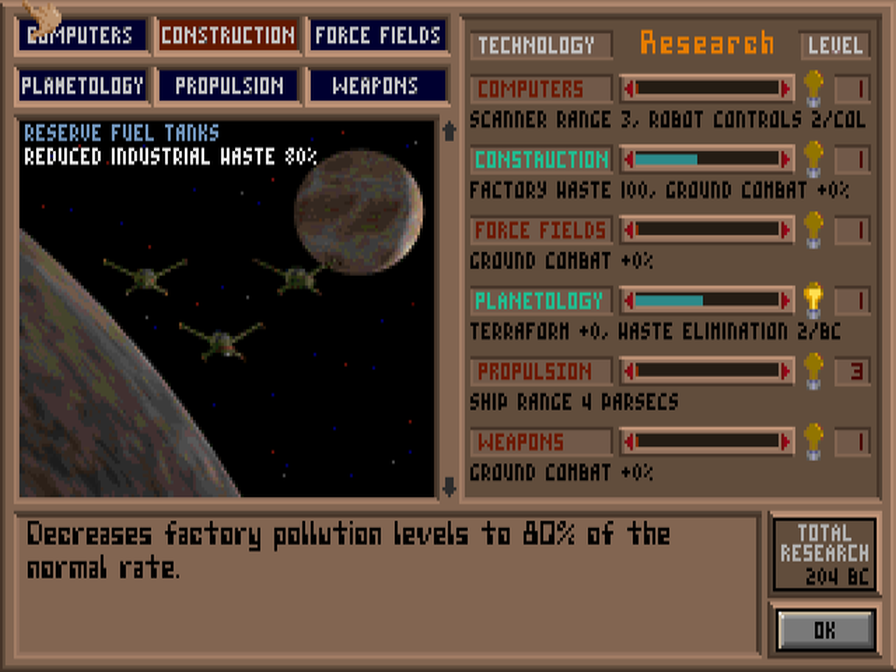
As you can see there's just a hair into the other four fields. This is an extreme split, and we won't keep up anything like this long-term.
Next time we'll get to one of the game's biggest surprises, and designing ships, among other events.